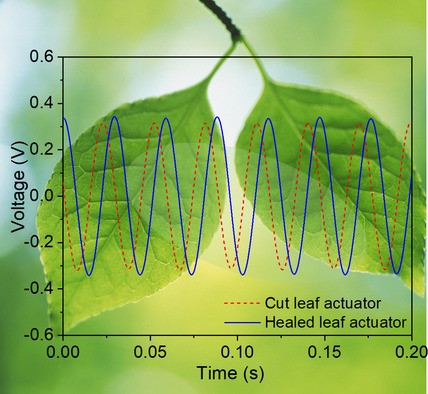· Soft robots must be made of a flexible and damage-tolerant material to avoid tearing
· Materials that can self-heal damages are therefore more desirable for soft robots
· A self-sensing and self-healing device that mimics a leaf's motion has been made by researchers at WMG, University of Warwick – potential for soft robots
Robots that resemble organs are known as soft robots, and in order for them to function they must be made of a flexible material, however a material that can also heal itself would be a bonus if wear and tear was to occur. Researchers from WMG, University of Warwick have designed a self-healing polymers for such devices.
Soft robots, that resemble organs for example, need to be made with highly deformable materials that are capable of changes in shape to allow conformable physical contact for controlled manipulation on order to decrease the chances of mechanical damage – such as tears and punctures.

This had led to a wide interest into the development of self-healing materials and actuators, in particular, the integration of self-healing polymers for bioinspired soft self-healing devices, which are lightweight, low cost and easily processed.
As an invited Communication by the journal Advanced Intelligent Systems, the work on 'Piezoelectric-driven self-sensing leaf-mimic actuator enabled by integration of a self-healing dielectric elastomer and a piezoelectric composite', was published on 22 March, 2021, led by the researchers from WMG, University of Warwick have designed a novel self-healing leaf-motion mimic material.
The material is made of an integrated thermoplastic methyl thioglycolate–modified styrene–butadiene–styrene elastomer (MGSBS) and piezoelectric macro fiber composite (MFC) for self-sensing applications.
The leaf-motion mimic actuator provides built-in dynamic sensing and self-healing capabilities to heal macroscale cutting damages with a room-temperature healing capacity and an intrinsic high bandwidth up to 10 kHz.
A prototype of the piezoelectric driven self-healing leaf was cut, and left for 24 hours at room temperature, in that time it had healed itself, after 48 hours it was almost untraceable where the cut had been made.
Dr Chaoying Wan, from WMG, University of Warwick comments:
"We have demonstrated the feasibility and potential of the new actuator applied to complex soft autonomous systems. This new material could fill a gap in the robotics-market, as the self-healing soft actuators can sense and repair themselves, creating new damage resistance in soft robotics.
"An example of where they could be used could be in a factory or hospital, they may get damaged from general wear and tear but can heal themselves and therefore do not need to come off duty to be fixed, therefore saving time and resources."






